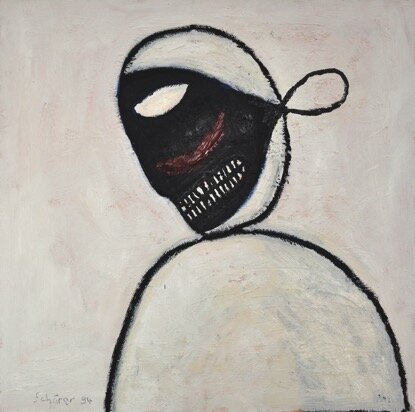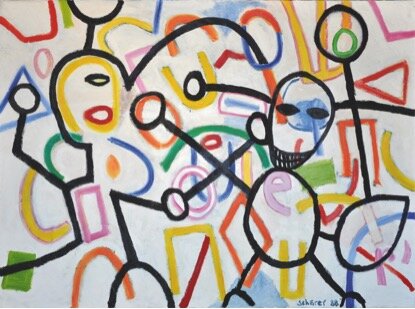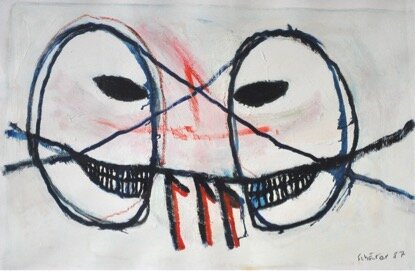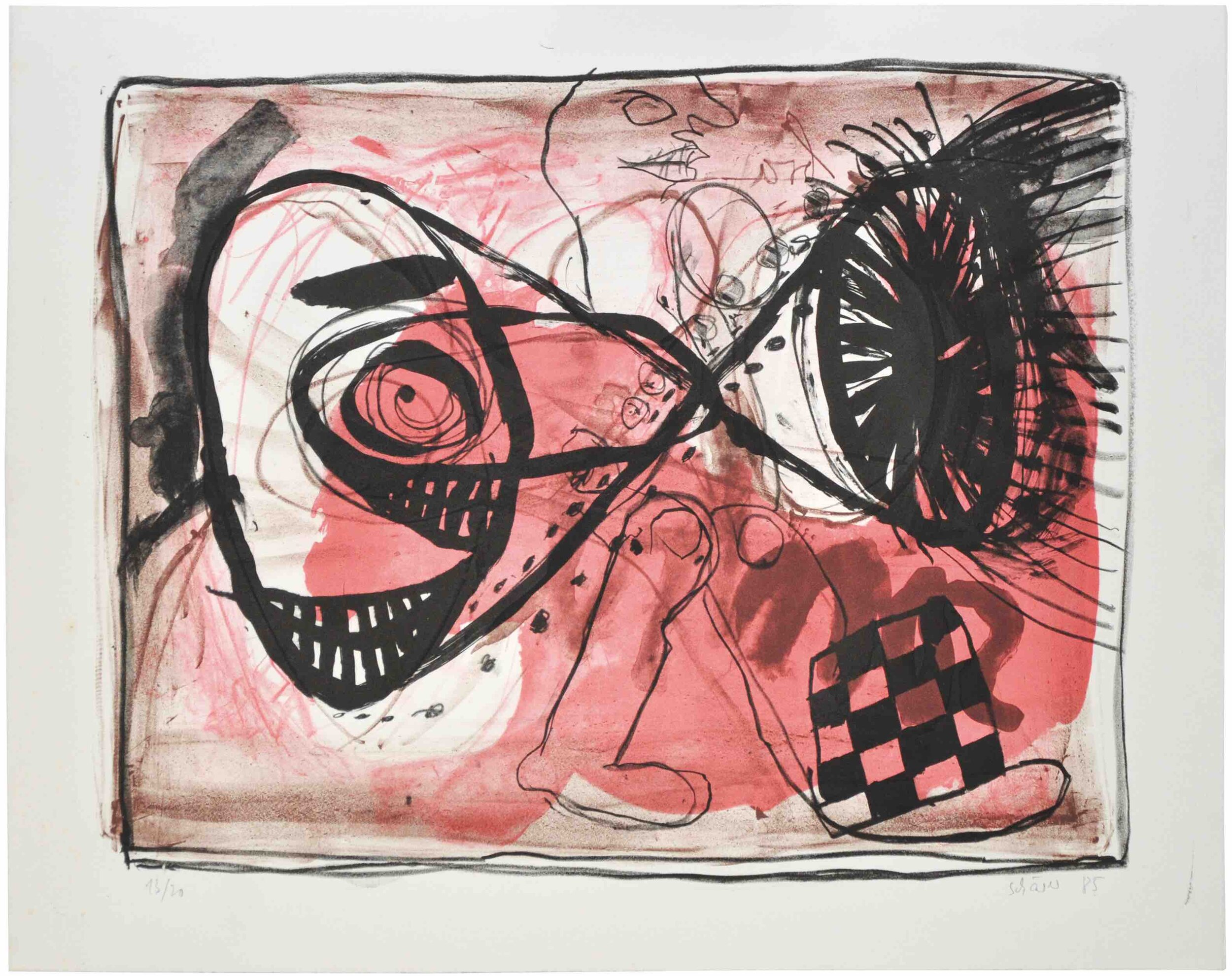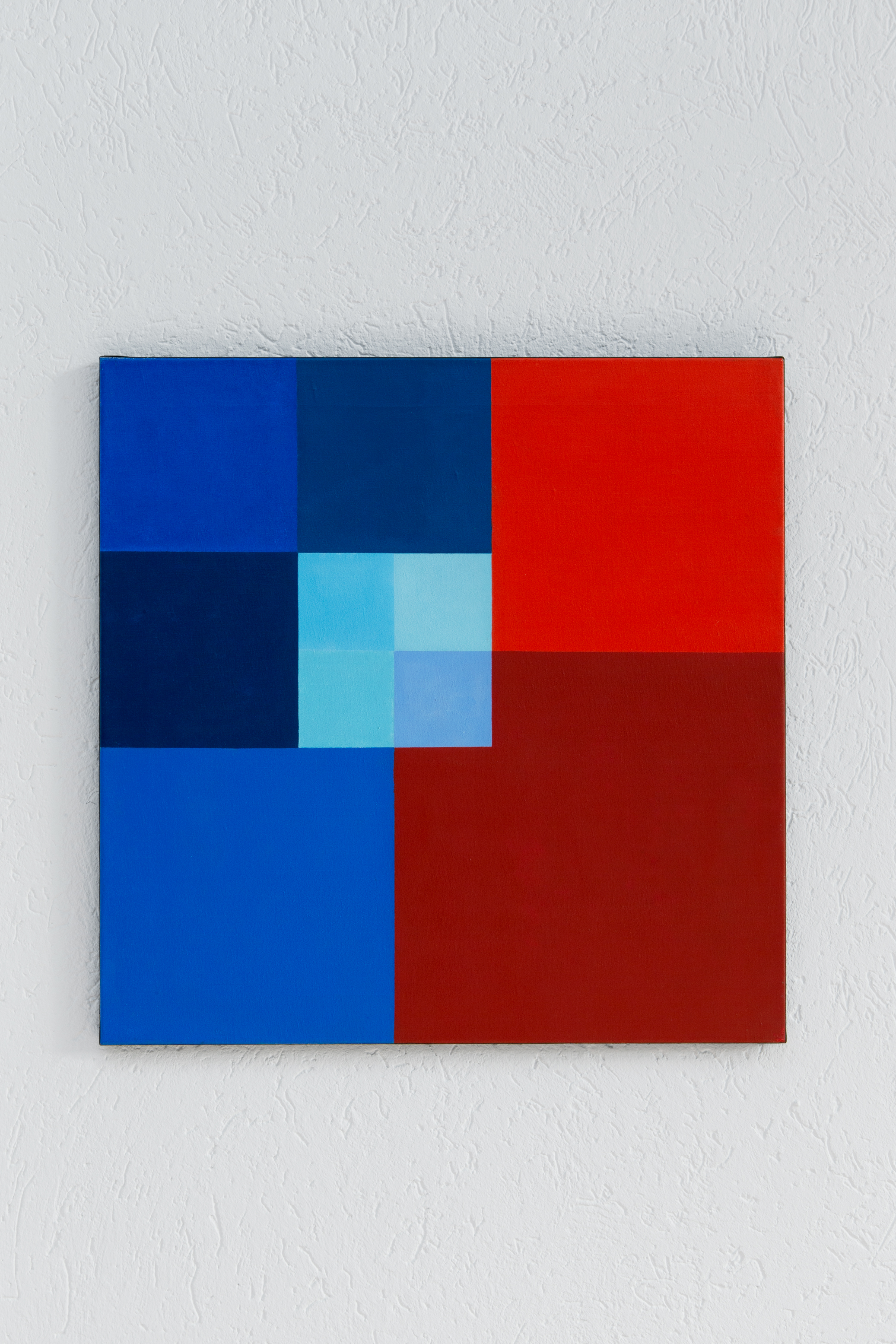Klaudia Schifferle *1955
Klaudia Schifferle is a Swiss artist, musician and poet. Born in Zurich, she made a name for herself in the late 1970s as a co-founder of the punk band Kleenex / LiLiPUT before turning increasingly to the visual arts. In 1982, she was the youngest artist to exhibit at Documenta 7. Life is at the centre of her interest, in particular the intermingling and exchange between different states of being. These aspects are essential for understanding her oeuvre, both in terms of content and her working method. Schifferle's works are characterised by an impulsive, intuitive approach. In her preferably large-format works, rough, crowded lines meet garish areas of colour, while abstracted faces and bodies populate her canvases and objects. Since her beginnings in the mid-1970s, her work has developed continuously. New materials and techniques are constantly finding their way into her work. Music also remains closely linked to her visual art. Recently, she has increasingly been working with spray paint and paper collages. In close collaboration with the artist, a solo exhibition was organised at Galerie Müller in 2024.
Rudolf Maeglin (1892-1971)
Rudolf Maeglin was a Swiss artist and wood engraver. The son of a Basel wine merchant, he grew up in an upper middle-class family, but decided, against family tradition, on an artistic career. In 1933, Maeglin was one of the founding members of ‘Gruppe 33’. From 1947, he lived in the working-class neighbourhood of Klybeck in Basel, working in factories and on building sites and painting the impressions of his everyday life at night. His construction site paintings document the rapid transformation of his home town Basel. His works include paintings, drawings and woodcuts. Maeglin was on show at Galerie Müller in 2024 as part of the exhibition La Fontaine de la Mort.
Max Sulzer (1926-2013)
Born in Riehen, he lived and worked in Basel, where he led a reclusive life and rarely presented his works to the public during his lifetime. His work was only made accessible to the public posthumously. Sulzer's works are characterised by a precise geometric formal language and a reduced colour palette that correspond to the principles of Constructivism. The clarity and rigour of his paintings are reminiscent of prints. In the 1960s, the compositions were still predominantly two-dimensional and two-dimensional. In the 1970s, perspective elements were increasingly added, while the works from the early 1990s appear more playful and take on almost ornamental traits. In 2019, Galerie Mueller in Basel dedicated an exhibition to Max Sulzer in which his work was presented to the public for the first time. In collaboration with the artist's estate and family, Galerie Mueller is organising Max Sulzer's first major posthumous solo exhibition. Paintings from all creative phases will be on display.
Sonja Sekula (1918–1963)
Sonja Sekula was a Swiss artist who lived and worked in New York for a long time. Her work moved in the field of tension between surrealism and American abstract expressionism, whereby she developed an independent and unmistakable position. Her works reflect an intense self-questioning and exploration of inner worlds, often manifested in colourful lines, abstracted forms and symbolic signs. Sekula deals intensively with themes such as identity, otherness and psychological turmoil. These aspects are also expressed in her poetry. Her travels also had a significant influence on her artistic work and awakened her interest in the indigenous cultures of the American continents. The artist achieved great success in the United States during her lifetime. She only gained international recognition posthumously when the Museum of Modern Art in New York acquired her work The Town of the Poor (1951) in 2018 and included it in its collection of abstract expressionist artists. In Switzerland, she was not honoured in this way for a long time.
Jean Tinguely (1925–1991)
Jean Tinguely was a Swiss sculptor, draughtsman and experimental artist. Born in Fribourg, he grew up in Basel and initially worked as a decorator. The characteristic signature of his later artistic work was already evident in his early wire works. In the early 1950s, he moved to Paris, where he established himself in the avant-garde art scene. Kinetic sculptures, moving and noisy metal constructions, some of which contain self-destructive elements, are a central component of his work. In addition to his sculptures, Tinguely created numerous drawings and often worked on collaborative projects with artist friends. In his later works, themes such as transience, death and destruction became increasingly present, giving his work a darker and more reflective dimension.
Werner von Mutzenbecher *1937
Von Mutzenbecher is a Swiss artist, filmmaker and writer. With his interdisciplinary approach, which continually explores the boundaries between art forms, he has a decisive influence on the Swiss art scene, particularly in Basel. In the 1970s, he developed the style of painting for which he became known: geometric painting that emphasised surfaces. In his photographs and films, on the other hand, he retained the figurative aspect and often appeared in front of the camera himself. From 1973, he also worked as a lecturer at the Basel School of Design and from 1987 to 2000 was head of the visual design class at the Basel Academy of Art and Design. In 2024, Von Mutzenbecher was part of the exhibition La Fontaine de la Mort at Galerie Müller.
KURT FAHRNER (1932-1977)
Kurt Fahrner was a Swiss painter and performance artist. After leaving school early, he worked in various fields before finally finding his way to art as a convinced autodidact. The unveiling of his painting of a crucified woman of our time on Basel's Barfüsserplatz caused a major scandal, after which he travelled to France and Denmark. He found artistic encouragement in Paris in particular and joined the La Ruche artists' colony. The exploration of opposites characterises Fahrner's work and often portrays erotic and provocative content. In 1964 he was awarded the European Prize for Painting. His work was presented at Galerie Müller in 2023 as part of the exhibition Junge Kunst 69: Fahrner, Kuhn, Schärer, Schibig.
Owsky Kobalt (1937-2019)
Owsky Kobalt was a Swiss sculptor and conceptual artist. She grew up in Basel and trained in painting, sculpture and stage design at the Basel School of Design. She also taught there as a lecturer for 25 years. In the course of her life, she travelled all over Europe and searched for suitable blocks of stone in quarries, which she brought to her studio to work on. Her studio, a quarry in Dittingen, was also her home. Not only geometric and architectural forms, but also found artefacts from nature played an important role in the search for form and shaping of her objects. Many of her works can be seen in public spaces in Switzerland. With more than thirty works, Galerie Mueller showed in 2022 a representative cross-section of Owsky Kobalt's work, for the first time in the new millennium.
Hans Schärer (1925-1997)
Hans Schärr was a Swiss painter, draftsman, sculptor, poet and musician.
Galerie Mueller in close collaboration with the Estate of the artist presents a first Basel solo show in autumn 2020.
Georges Noël (1924-2010)
Georges Noël was a French abstract painter and sculptor.
Galerie Mueller in close collaboration with the Estate of the artist presented a first Basel solo show in summer 2019.
hedi mertens
(1893-1982)
Hedi Mertens was an important Swiss painter of abstract and concrete paintings.
In close collaboration with the Estate Galerie Mueller presented works from by Hedi Mertens in a group show in spring 2019.




























